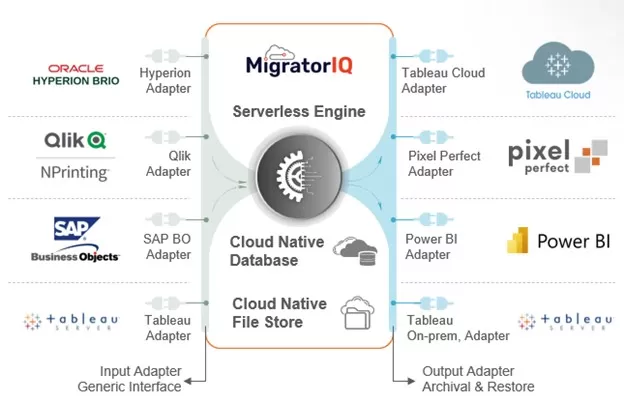Navigating Turbulent Times: Strategies for Analytics Platform Optimization
Cost Reduction Strategies: A Closer Look at Analytics Platforms
Implementing Optimization Measures: Practical Insights for Organizations
Analytics Platform Migration Options and Considerations
As discussed in Part 1 of this series, the most significant challenge that organizations struggle with when looking to modernize their analytics platforms and capabilities is determining how to migrate existing assets, ie. reports, dashboards, ETL workflows and data sources, to the new platform with minimal cost and disruption. In many if not most cases, the legacy platforms are not apples to apples solutions compared to the target platform. They have different formats and visualization methods, varying data model structures and transformation approaches. Further, users of these platforms have grown accustomed to these solutions and organizations must plan for change management, training and enablement to prepare users.
Introduction to Analytics Platform Optimization
Analyzing Analytics Platform Costs: Identifying Areas for Optimization
Strategies for Cost Reduction in Analytics Platforms
Practical Insights: Implementing Optimization Measures
Understanding the Importance of Analytics Platform Optimization
Identifying Cost-saving Opportunities in Analytics Platforms
Implementing Cost Reduction Measures: Best Practices and Considerations
Case Studies: Real-world Examples of Successful Optimization Strategies
Maximizing Analytics Insights
Many organizations have accumulated hundreds and thousands of reports with related data sources and complex data transformation workflows. When confronted with the daunting task of migrating these assets, organizations have a few options. These options typically are defined as Decommission/Retire, Manual Recreation, Automated/Semi-Automated lift-and-shift, or Automated/Semi-automated optimized migration. Of the four options, the Automated/Semi-automated options only exist where solutions have been created and are offered in the market.
In the first option, companies can choose to decommission existing assets, and, in most cases, this is a good place to start. It forces companies to assess their report inventory and clean up unused or duplicate reports. This obviously is not a good option for reports that are currently used to run the business. The remaining reports that are still used are where consideration of the next three options comes into play.
The second option is to manually reproduce reports, data models and transformation processes on the new platform. Unfortunately, manually recreating large numbers of reports can be a very time consuming and expensive process that can take years in some cases to accomplish. This reality leads us to the third and fourth options that include some degree of automation to make the migration financially feasible and timely.
The third and fourth options involve trying to identify an automated or semi-automated approach/tool to lift-and-shift existing assets to the new platform. The third option focuses on duplicating the existing population of reports and data models on a modern platform, while the fourth option looks to optimize data models, transformation and report designs during the process. These two options tend to be optimal for most organizations IF such a solution exists.
USEReady’s Expert Guidance
Regardless of the choice made, it is important to identify and follow a formal process that includes asset analysis, migration strategy definition, prioritization and planning, migration execution, quality assurance and organizational change management and enablement. USEReady has created a framework that is based on our experience and the use or multiple migration accelerator components that help to manage and accelerate the overall effort. The process at a high-level is represented as follows:

Identifying Redundant Analytics Platforms
Once the target analytics platform has been identified, the first step is to begin to analyze the existing inventory of analytics assets to determine what must be migrated. This process gathers the full picture of the existing inventory of reports, dashboards, transformation workflows and data sources across existing platform repositories. In some cases, this analysis can be automated or semi-automated through tools like USEReady’s MigratorIQ – Legacy Analytics Inventory Analysis Accelerator.
Streamlining Data Collection and Processing
The next step is to assess the inventory to determine which assets can be retired and identify assets that are duplicates or that may be combined if certain minor changes are made. This rationalization exercise helps to reduce the number of assets that need to be migrated. Once this step is completed, reports can be grouped based on certain criteria that will simplify the migration. This step also includes prioritization of reports. This stage is part of the migration strategy and planning stage. USEReady’s MigratorIQ – Legacy Analytics Inventory Analysis Accelerator also helps to facilitate this stage in an automated or semi-automated manner, depending on the source platform.
Improving Analytics Data Visualization
Once the inventory is complete, including asset metadata extraction, report grouping/categorization, rationalization and prioritization, the migration can begin. Migration options are often limited in the way of available automation and semi-automated solutions. These options also depend on your source and target platforms as all source legacy systems are not simple mappings to modern target platforms.
Partnering with UserReady for Expert Analytics Guidance
USEReady has developed a migration acceleration program called MigratorIQ that is a framework and set of tools that automate or semi-automate migrations that are coming from source platforms like Qlik, Business Objects, Cognos, and Hyperion, and are moving assets to Tableau. The approach maps data models from the source platform to Tableau extracts, and it groups and maps source platform reports to a set of Tableau templates, in some cases also leveraging USEReady’s Pixel Perfect solution for perfectly formatted, print-ready reports.

Our next post will go into more detail about the options made available by USEReady’s MigratorIQ migration acceleration program and discuss what options exist depending on your platform and current data and analytics ecosystem.
To learn more about the options and how USEReady’s Legacy Platform Migration solutions can help, contact us at marketing@useready.com.


